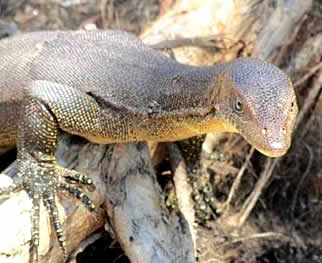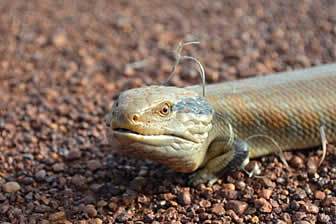The work of the Kimberley Community group Kimberley Toad Busters has clearly shown that by controlling cane toad population numbers in a given area you minimise the chance of native predators attacking and consuming a toad, which in turn reduces the number of native animals dying from the direct impact of the cane toad. Keeping toad numbers under control also helps the smaller insect eating native predators such as frogs, smaller skinks and lizards by reducing food competition.
With cane toads capable of eating around 200 insects a night, uncontrolled numbers of cane toads increases food competition very quickly.
|
 |
| One of the surviving Merten’s Water Monitors |
|
 |
| One of the surviving egg eating Blue tongued lizards around the KTB Kununurra Depot |
|
Jordy Groffen added. “By reducing the food competition a larger number of the smaller native animals stay alive, which in turn provide a healthy meal for the bigger native predators. Even if the bigger native predator has learned to avoid the toxic cane toad in times when the food supply is low they are known to still try to consume a cane toad and often with a negative ending for both toad and native predator”.
Lee Scott-Virtue, President & Founder of KTB commented that “Although the cane toad has had a devastating impact on the wildlife in and around Kununurra there are multiple toad controlled areas where the impact on the wildlife is remarkably less, thanks to community efforts”. |
|
Jordy Groffen Animal Scientist at KTB stated “KTB has controlled the cane toad population level from the first arrival in the area around the KTB Kununurra based headquarters, not always an easy task with thousands of toads removed over the years, but the effort has been worth it!” Before the toad invasion, a good population of blue tongued lizards, pythons, yellow spotted monitors and even the odd merten’s monitor frequented the area around the KTB headquarters. “These species and especially the varanid lizard and the blue tongued are highly impacted. In some uncontrolled areas you get a 100% loss of blue tongued lizards and a 70%-97% loss of bigger varanid lizards” stated Jordy Groffen, KTB researcher and Animal Scientist. |
He added that “four years after the toad invasion we still see lots of the same blue tongued lizards, which we recognize because they were stealing our eggs out of the chook pen and many lizards often missing a part of their leg. The population of varanid lizards have gone down, also in our controlled toad area around the KTB headquarters. However, there are still a couple of survivors around and if they have survived 4 years of cane toads they now know to avoid this toxic meal”.
“Even better news is that we have recently spotted a couple of young yellow spotted monitors, which means that they know to avoid the cane toad as well and that in time we may actually begin to see an increase in the population around KTB headquarters” stated Dean Goodgame ,co-founder of KTB,
Zigourney Nielsen, Bachelor of Biological Sciences and volunteer research assistant at KTB, stated “In some areas the cane toad density is so high that I couldn’t believe that there was any other wildlife around”. Zigourney continued “You clearly see the difference between a cane toad controlled area and a non-controlled area. While we only saw some birds and skinks in the non-controlled area we saw two pythons, a Blue tongue and Bandicoots in a controlled cane toad area”.
The last word goes to Dutch Animal Scientist Leonie Jacobs. “During my six months research work with Kimberley Toad Busters, community efforts in reducing adult toad population numbers as well as any subsequent breeding cycles from the moment toads arrived in an area definitely seemed to impact on the rate and extent of native predator species loss. I think community involvement in assisting towards minimising native biodiversity loss is critical”.
| For further information or high resolution photographs please contact Lee Scott-Virtue 08 91687080 |
If everybody became a toad buster.
The toads would be busted! |

